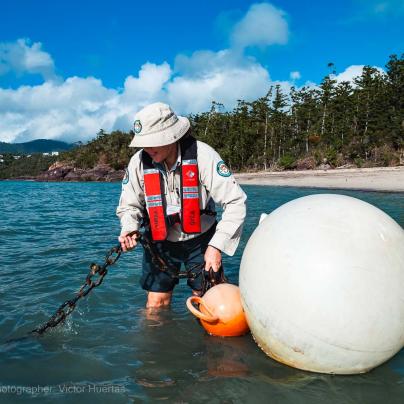- Quick links:
- Field Management Program video
- Reef Joint Management Program Business Strategy Summary
- Annual Business Plan Summary
Each year more than two million people visit the Great Barrier Reef. For many Reef users, the public face of the Great Barrier Reef Marine Park’s management effort is the field officers they meet when they’re out on the water or on an island.
Field officers are crucial to the management of the World Heritage Area. This includes making sure there is up-to-date regional and site-specific information for visitors, education groups and commercial users on how to enjoy the Reef responsibly.
Facilities such as public moorings, reef protection markers, campgrounds, picnic areas and amenities, walking tracks and lookouts are there to ensure everyone can have a great time out on the Reef and its islands while looking after them for future visitors.
What does the Field Management Program do?
The Field Management Program maintains 127 reef protection markers where there is no anchoring allowed and 128 public-use moorings.
This infrastructure protects the Reef where anchoring would otherwise damage the fragile reefs visitors come to enjoy and facilitates use at sites where visitation is high.
They also look after 163 kilometres of walking track, 111 campgrounds, 21 boardwalks and lookouts and 15 kilometres of public roads.
These well-constructed visitor facilities provide safety and enjoyment to visitors and help protect the environment from human impacts.
Further information about island national parks is available at the Department of Environment, Science and Innovation. Here you can obtain information about the natural and cultural values and the facilities of the island you are visiting.
Some islands in the Great Barrier Reef World Heritage Area are Commonwealth Islands that are subject to private lease arrangements and Department of Defence activities or are managed by a caretaker.
These islands have additional management arrangements in place.





Out on the water, the Great Barrier Reef Marine Park Authority and the Queensland Department of Environment and Science, through the Queensland Parks and Wildlife Service, operate a joint field management program for the marine and island national parks, encompassing the Great Barrier Reef Marine Park and the Great Barrier Reef Coast Marine Park.
The field team delivers practical on-ground actions to protect and maintain well-functioning marine and island ecosystems that support the Great Barrier Reef's economic, traditional and recreational uses.
- Their work involves:
- conservation and monitoring
- incident response
- welcoming visitors
- upholding compliance.
Annual business plan summaries
The Program's annual business plan summaries highlight the activities and priority projects for each financial year, aimed at protecting the World Heritage Area from threats, building resilience for marine habitats, islands and species, strengthening partnerships with Traditional Owners, and supporting ecotourism opportunities.
- Reef Joint Field Management Program: Annual Business Plan Summary 2024–25
- Reef Joint Field Management Program: Annual Business Plan Summary 2023–24
- Reef Joint Field Management Program: Annual Business Plan Summary 2022–23
- Reef Joint Field Management Program: Annual Business Plan Summary 2021–22
- Reef Joint Field Management Program: Annual Business Plan Summary 2020–21
More than 348,000 square kilometres of coral reef and its surrounds make up the Great Barrier Reef World Heritage Area — an area the Reef Joint Field Management Program has been protecting for more than 40 years in on-ground, practical ways.
The Program is run jointly by the Great Barrier Reef Marine Park Authority and the Queensland Department of Environment and Science, through the Queensland Parks and Wildlife Service.
We strive to bring the work of this program closer to partners, stakeholders and the community. This magazine features exciting case studies of the Reef Joint Field Management Program.
Find out more about the Reef Joint Field Management Program’s five-year strategic direction in the Business Strategy 2025–2030. It sets out actions across five key themes to meet the Reef’s needs.
Previous editions:
Find out more about the Joint Field Management Program’s activities and achievements by downloading the annual report summary.
- Field Management Program summary 2023-24
- Field Management Program summary 2022-23
- Field Management Program summary 2021-22
- Field Management Program summary 2020–21
- Field Management Program summary 2019–20
- Field Management Program summary 2018–19
- Field Management Program summary 2017–18
- Field Management Program summary 2016–17
- Field Management Program summary 2015–16
- Field Management Program summary 2014–15





